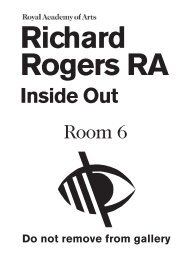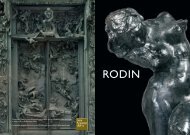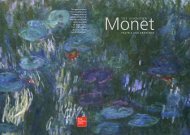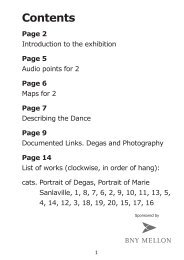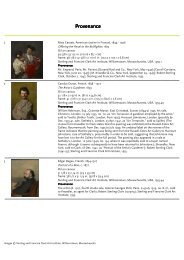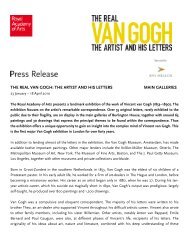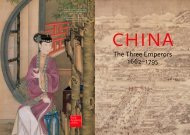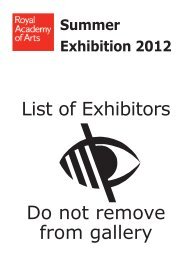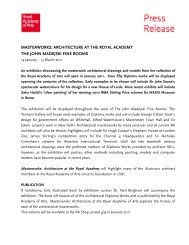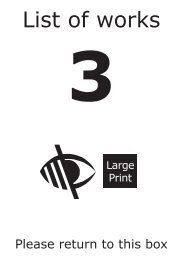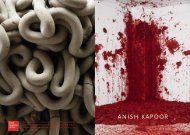KIRCHNER - Royal Academy of Arts
KIRCHNER - Royal Academy of Arts
KIRCHNER - Royal Academy of Arts
You also want an ePaper? Increase the reach of your titles
YUMPU automatically turns print PDFs into web optimized ePapers that Google loves.
sense <strong>of</strong> living dangerously in a great capital city on the edge <strong>of</strong> a<br />
catastrophe in a way that no other European painting did at the time.’<br />
Cat. 130<br />
Friedrichstrasse<br />
Oil on canvas, 1914<br />
One <strong>of</strong> Kirchner’s most famous ‘Streetwalker’ paintings is the outstanding<br />
large-format work Friedrichstrasse. In it, three elongated women (probably<br />
prostitutes) confront the viewer like magnificently plumed birds whose<br />
feathers jut out showily in different directions. Behind them queue<br />
anonymous suited men, their blank expressions suggesting urban<br />
automatons. Kirchner has invested the scene with extreme erotic tension:<br />
the men’s and women’s forms interlock and mimic each other in a<br />
deliberately ambiguous manner.<br />
Standing close together in a noisy, crowded street, none <strong>of</strong> the figures<br />
appear to be interacting with each other in any meaningful way.<br />
What comment do you think Kirchner is making about the isolated<br />
individual in the bustling metropolis?<br />
Kirchner’s style becomes increasingly dramatic during these years. Look at<br />
these works and examine his jagged, almost violent brushwork, the<br />
energetic composition, and the pointed figures with their unnaturalistically<br />
exaggerated limbs. The long black brushstrokes that extend from these<br />
figures’ hands and feet give a Futurist sense <strong>of</strong> movement and speed.<br />
What other things would you comment on regarding Kirchner’s method,<br />
approach, mood and influences in the ‘Streetwalker’ paintings?<br />
WOODCUT PRINTS<br />
‘Kirchner, excited by the old woodcuts he had seen in Nuremburg,<br />
brought the woodcut with him from South Germany and took up the<br />
tradition again.’<br />
Kirchner, writing in the Brücke chronicle in 1913<br />
As Kirchner’s work became more graphic and his use <strong>of</strong> line more striking,<br />
his interest in the traditional German medium <strong>of</strong> the woodcut was<br />
renewed (see cats 136, 144, 145, 148–156). Inspired by the masterly prints <strong>of</strong><br />
Albrecht Dürer, Kirchner succeeded in revitalising the technique and giving<br />
it a new, innovative rhythm. He loved the expressive power <strong>of</strong> Dürer’s<br />
woodcuts (particularly his Four Horsemen <strong>of</strong> the Apocalypse series) and<br />
emulated Dürer’s use <strong>of</strong> hatching and richly contrasting light and dark<br />
values to give his woodcuts a painterly quality. Although he occasionally<br />
adapted German Gothic iconography, Kirchner also developed his own<br />
pictorial vocabulary, using a blockish, simplified language that would<br />
become the model for the other Expressionists.<br />
16<br />
‘The greatest German master is<br />
Dürer, he embodies all other<br />
German painters <strong>of</strong> the Middle<br />
Ages, and the new German art<br />
will recognise him as its father.’<br />
Kirchner




